By Amy Brennan
On June 30th #G2Great continued our journey with Jan Burkins and Kim Yaris in the third of a four-part series inspired by their book, Who’s Doing the Work: How to Say Less So Readers Can Do More (Stenhouse 2016). As I reflect on the series and re-read my own marked up and treasured copy of their book I feel compelled to stand once again on our #G2Great metaphorical mountain and shout out to all educators to get a copy of this book, read this book and take on the charge to lead students to independence in reading.
Jan and Kim introduced us to next generation guided reading in chapter 4 of their book. The quote above from Jan and Kim resonates with me because over the years as I have worked with students and teachers around guided reading this was the thing that got me stuck each time. I did not see the transfer happening and it seemed like the adults (including myself) were doing much of the work while students took on a role that seemed more compliant than cognitive when it came to engagement and strategic work in the reading process. In fact, if I am honest, I generally opted for strategy groups or some hybrid type of small group rather than guided reading for this very reason.
As I read the book and reflect on the chat I am making connections between the importance of teaching towards independence for our students in school and raising my teenagers to be independent in life. In my mind I believe one thing, but when I look back and reflect over my own words and actions I realize that in literacy and in life I am guilty of providing too much support so that my students and my own teenagers are still dependent on me when what I believe is that I want them to be independent. My actions and words have not been aligned to the end result I was seeking. I want independence for these learners, however I am so worried about the mistakes that happen along the way in the learning process that I jump in and sabotage their journey to independence.
Picture this, you are teaching your child to ride a bicycle, you hold onto the back of the seat. You run along behind, still holding the seat. Back probably aching, but you are not worried or scared because you are holding on. Your child is excited, perhaps slightly scared but more excited about the potential of riding on their own like a big kid. You want to let go of the seat, but you can’t. You are worried about what will happen if you let go. Then as your brother watches, he steps in because he knows you will never let go of the seat and his nephew will never learn to ride that bike if his mother continues to hold that seat.
This was me and unfortunately, I am still trying so hard to let go of that seat. This book has helped me professionally and personally to realize that I have to let go of the seat. To do that I need to ensure that I provide an environment where there is safety while also letting students (or my teenagers) make the more specific decisions. I can still provide support by setting up metacognitive prompts or questions to support their thinking, not mine. I can provide prompts that are both general and reflective with lean coaching in with agentive questions such as, “What can you try?” “What do you know?” and “What else can you try?” In other words, I can adjust my teaching to afford students the benefits that come with next generation guided reading.
Next Generation Guided Reading Encourages Problem Solving
In reflecting on the June 30th chat, Elisa’s tweet above reminds me why it is critical to support independence in our learners. Guided reading is the step just before independent reading when we consider its relation to the gradual release of responsibility. When we provide too much support or do all the work, students are not prepared to do that work on their own. They do not have enough practice in problem-solving in order to know when they are stuck and what to do when reading breaks down. Students can practice using their problem-solving skills when our questions or prompts allow students to figure it out themselves. Questions such as “What can you try?” “What do you know already?” and “How can you check?” provide just enough support that it encourages students to think and problem solve so that when they are on their own reading independently they can apply these strategies alone. These reflective or metacognitive questions promote thinking promote thinking that will enhance awareness into their own processes as well as the flexibility to use these in other texts independently.
Next Generation Guided Reading is Student Led
Teachers use next generation guided reading as an opportunity to learn about students’ reading processes. Rather than providing a heavy book introduction, teachers of next generation guided reading approach the book introduction as a facilitator of the work that leads to independence. Teachers may ask “How will you figure out what this book is about? Or “What should we do first to get started in this book?” This provides an opportunity to observe and learn from students so that instruction can be more intentional and specific to support independence in reading. Additionally, as Lisa’s tweet below points out that too often a lengthy book introduction takes away precious reading time for students. If we want independent readers we need to provide the time for students to engage in just that, with our careful observing eyes and ears as we take note of what students are doing and only jumping in when necessary. Teacher talk is minimal in next generation guided reading, allowing students to talk, think and process the text. Often teachers lament on not allowing for enough wait time, but if we reframe the term wait time to processing time perhaps we can trick ourselves into waiting longer as students are processing or thinking about a text.
I have come to the realization that indeed it is scary to let go of the seat of the bicycle and let them ride off into the sunset. Perhaps that is why my brother and sister in law had to teach my children how to ride a bike. However if I watch this “video” play through in my mind again I can see different ways I could have improved my teaching by letting go of the bicycle.
Picture this new scenario, you are teaching your child to ride a bicycle, you hold onto the back of the seat. You run along behind, still holding the seat. Back probably aching, but you are not worried or scared because you are holding on. Your child is excited, perhaps slightly scared but more excited about the potential of riding on their own like a big kid. You want to let go of the seat, but before you do you watch your child’s pedaling, you watch your child’s balance and you watch your child keep their eyes on the road and their hands steady on the handlebars. You observe and assess when they are ready for you to let go of the seat. You prompt your child with lean coaching as you are still holding on, but lighter than before. You are not worried about what will happen if you let go because you have worked through possibilities with your child and planned for get up again and try it strategies. You know that when you let go they might lose balance that first time and fall, but you will problem solve and talk through how to fall and how to get up again. Then as your brother watches, you let go, your child loses balance and falls. Your child gets up, shrugs off the fall and says, “Next time I will go longer without you holding on!” Your brother runs over and gives your child a high five and flashes a knowing smile in your direction. Before you know it…your child is off and riding. That’s what doing the work looks like in next generation guided reading — our students are off and reading.
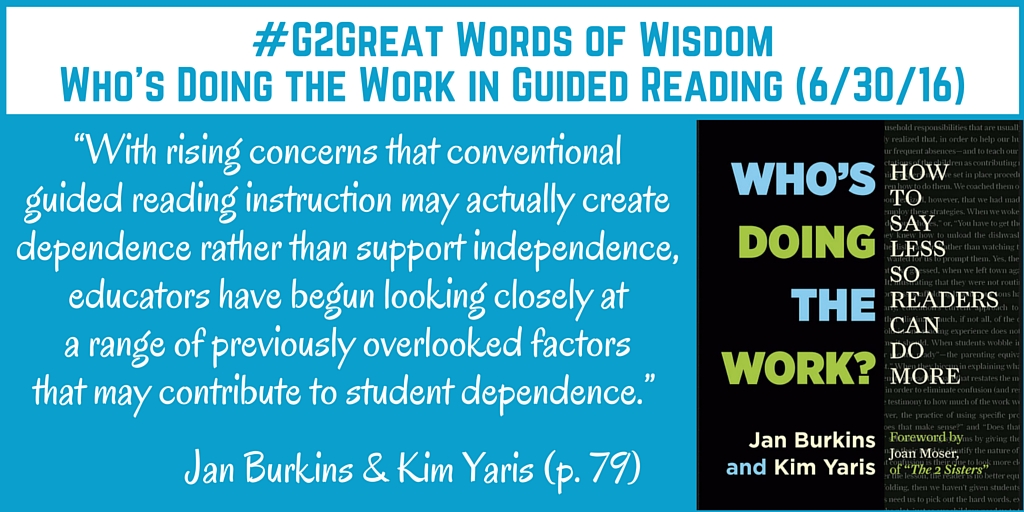


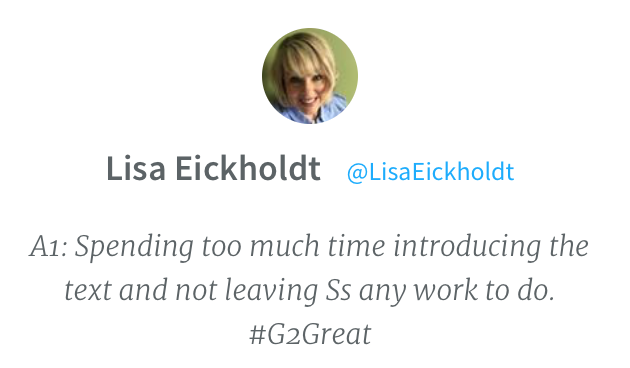
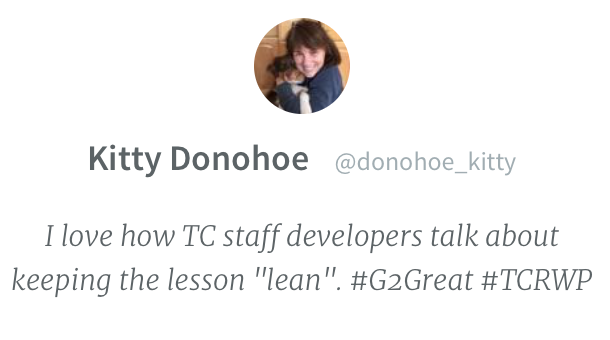
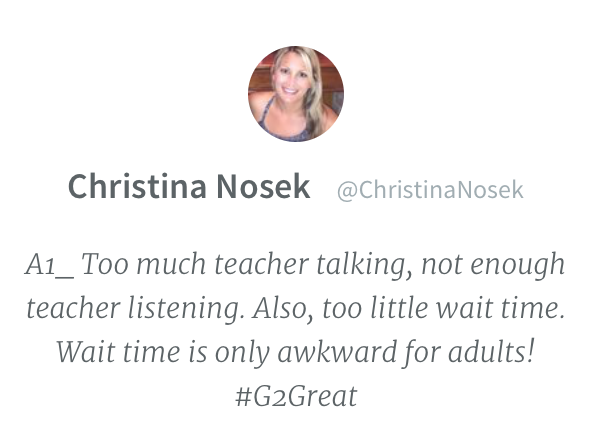
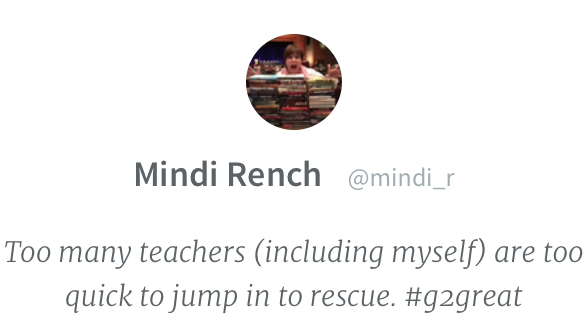




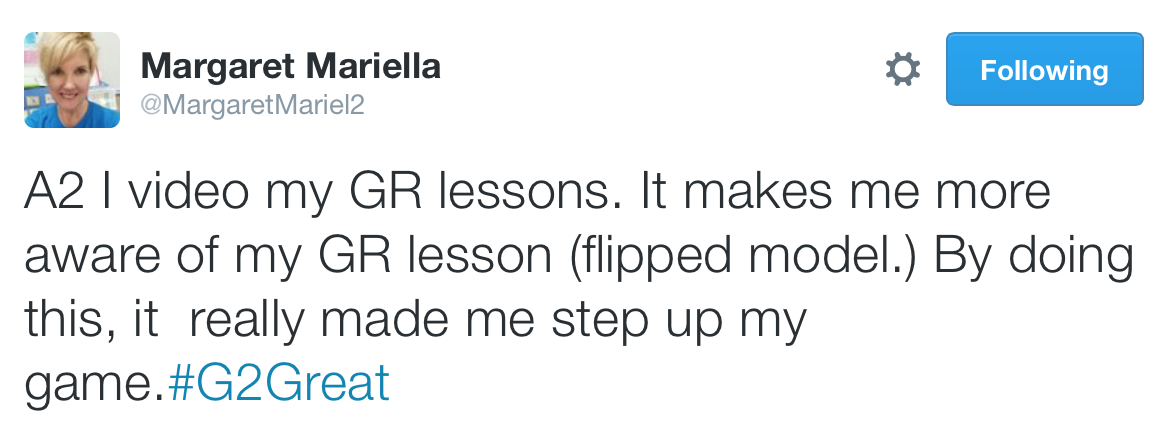


Thanks for this summary post of the last Twitter chat. I like your new scenario of what it would look like to teach a child how to ride a bike with independence in mind. How we observe, watch and take note of what kids are able to do in order to let them go do it! We don’t let them crash and fall. We provide supports – the questions that you suggest above – to help them figure it out for themselves.